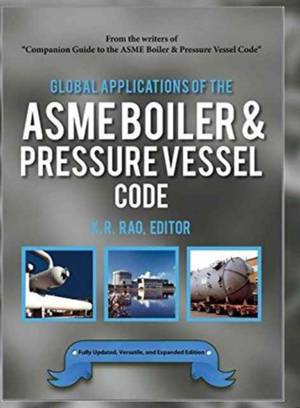
- Afhalen na 1 uur in een winkel met voorraad
- Gratis thuislevering in België vanaf € 30
- Ruim aanbod met 7 miljoen producten
- Afhalen na 1 uur in een winkel met voorraad
- Gratis thuislevering in België vanaf € 30
- Ruim aanbod met 7 miljoen producten
Zoeken
€ 433,45
+ 866 punten
Omschrijving
his publication follows the phenomenal success of not only the four editions of the Companion Guide to the ASME Boiler & Pressure Vessel Code published by ASME Press, but also two related updated volumes. Thus, this is the third book that is also a "standalone-publication," addressing Global Applications of the ASME B&PV Code. This book not only updates information of 16 chapters of the third volume of the third edition of the Companion Guide, but has additional 5 chapters selected for their unique features of ASME Boiler and Pressure Vessel Codes used internationally. This book has five parts addressing Global Applications of ASME B&PV Codes and Standards: Part 1: North America and Western Europe which includes Canada, France, UK, Belgium, Germany, Spain and Finland in addition to the Pressure Equipment Directive of the European Union Countries. Part 2: Central and Eastern Europe includes Russian, Czech and Slovakian Codes and Hungary. Part 3: South Africa. Part 4: Asia including Japan, Korea, Taiwan, India and China. Part 5: Special Topics is addressed by ASME Code experts to cover in four chapters: (i) Global Harmonization of Nuclear Codes and Standards; (ii) Global Flaw Modelling Characteristics; (iii) AREVA's perspective of spent fuel storage in a "A Case Study of Dry Storage System for Used Nuclear Fuel; and finally in last chapter (iv) Has three parts in "Utilities' perspective of spent fuel storage" - the first one is covers ENTERGY, the second part Pacific Gas and Electric (PG&E) and the last part has Ontario Hydro's experiences. Thus different perspectives of the Spent Fuel Storage which are critical to the continuation of nuclear industry are addressed by various experts in this chapter.
Specificaties
Betrokkenen
- Auteur(s):
- Uitgeverij:
Inhoud
- Aantal bladzijden:
- 508
- Taal:
- Engels
Eigenschappen
- Productcode (EAN):
- 9780791861073
- Verschijningsdatum:
- 1/05/2016
- Uitvoering:
- Hardcover
- Formaat:
- Genaaid
- Afmetingen:
- 216 mm x 279 mm
- Gewicht:
- 1456 g

Alleen bij Standaard Boekhandel
+ 866 punten op je klantenkaart van Standaard Boekhandel
Beoordelingen
We publiceren alleen reviews die voldoen aan de voorwaarden voor reviews. Bekijk onze voorwaarden voor reviews.











